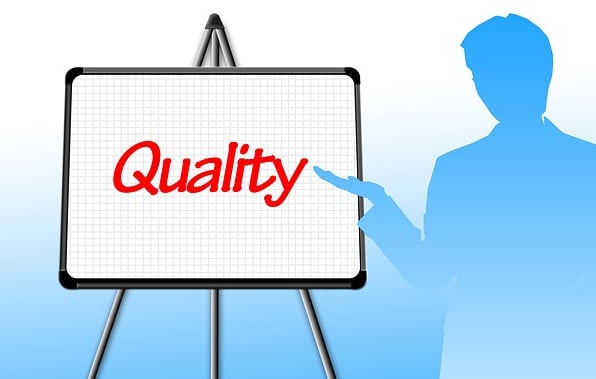
High school grades are very important in the college application process, but they may not always be the most accurate reflection of a student’s abilities. Grade inflation is a problem in many high schools, and it can result in issues down the line in terms of college performance and admissions chances.
In this article, I’ll go through what grade inflation is and how it affects you as a high school student.
What Is Grade Inflation?
Unfortunately, grade inflation is not when your teacher decides to give you a balloon with your grade written on it instead of a report card (that would be kind of nice because even if you did badly, hey, a balloon). Grade inflation is when average grades are skewed artificially high because class assessments are too easy and/or teachers are too lenient.
If grades are inflated because a teacher is an easy grader, the average grade for a class will not accurately reflect the quality of the students’ work. A student might get an A on a project that really deserved no more than a B. If grades are inflated because a teacher gives easy assignments, the average grade will only reflect students’ ability to complete simple tasks and not an understanding of the complexities of the material. Often, both of these problems are present at once in the case of classes that have severe grade inflation.
Grade inflation happens for several reasons. High schools want to look good in comparison to other schools with less grade inflation, so it’s beneficial for them to give out high grades even if those grades are not fully earned. This makes the student body look more high-achieving and the teachers appear more effective. Some teachers may also avoid giving low grades because kids and parents will complain and make more trouble for the teacher than it’s worth.
Teachers might also give higher grades to students who haven’t fully earned them because they don’t want to ruin students’ chances for college or prevent them from participating in extracurricular activities. Since a much higher percentage of students attend college nowadays, it makes sense that average grades have risen significantly. A decent GPA is critical if a student hopes to be accepted to college, and teachers don’t want to ruin anyone’s future.
 Grade inflation?
Grade inflation?
Is Grade Inflation a Problem in High Schools?
Overall, yes, grade inflation is an ongoing issue in high schools. This is not to say that all grades in high school are inflated; situations vary significantly from school to school and also between classes in the same schools. Based on the data, however, we can see a general trend towards higher average high school grades over the years.
From 1990 to 2009, average high school GPA increased by .33 points for female students (from a 2.77 to a 3.1) and .31 points for male students (from a 2.59 to a 2.9). In 2007, the National Household Education Survey reported that 81% of high school students receive mostly As and Bs in their classes. The average high school GPA is now around a 3.0, which translates to a B average.
High schools don’t want to look like they’re performing poorly in comparison to the competition, so they may give students more slack to avoid high numbers of failing grades or a larger percentage of dropouts.
Is Grade Inflation a Problem at Colleges?
It’s not just high schools that struggle with grade inflation. Colleges are even worse offenders, and it’s often the most selective colleges that have the biggest problems with grade inflation. The average GPA at four-year colleges is around a 3.1, but grades may be more or less inflated based on the school you attend and the major you study. For example, the average GPA for education majors is a 3.36 while the average GPA for chemistry majors is a 2.78. Overall, humanities majors have higher GPAs on average. As I mentioned, highly selective private colleges tend to have the worst grade inflation. The average GPA at Stanford is a 3.55! You can learn more about average college GPAs in this article.
Grade inflation is more of a problem in college for several reasons. Professors are sometimes judged based on student feedback, and students who earn poor grades often blame the professor or criticize the class in retaliation. This happens mostly with adjunct professors who have semester-long contracts that may or may not be renewed based on their performance. Bad reviews can be very harmful to new professors who are vulnerable in their careers.
Students and parents also expect high grades so that they can feel like they’re getting the most for their money (this partially explains why expensive private colleges have more problems with grade inflation). Professors also don’t want to ruin students’ chances in the job world or the graduate school application process. Since the world has normalized Bs as average, giving out lower grades can do a lot of damage to a student’s future.
What Are the Consequences of Grade Inflation?
Grade inflation in high schools has numerous positive and negative repercussions for students. It is a problematic trend in general, but it can provide some benefits to students who are struggling.
The Positives:
More Students Have a Chance of Attending College
Grade inflation in a high school means that more students will have good GPAs and better chances of attending higher education institutions. Of course, since colleges know that grade inflation exists, many have adopted higher admissions standards. However, in schools with grade inflation, more students will meet the bare minimum requirements for getting into college.
Students with GPAs that are above a 2.0 (or a C average) in high school can usually expect to be admitted to at least one less selective college as long as their test scores aren’t extremely low. This means that even students who perform at a level significantly below average in high school have a chance of attending college. Some students end up doing much better in college than in high school because they’re more interested in what they’re studying and are less distracted by problems at home.
Students Are Less Likely to Give Up on Education
If you’re failing a class, it can be tempting to say “I’m not cut out for this” and stop trying or drop out of school completely. Since teachers are giving out fewer failing grades, this is less common now than it was even twenty years ago. The overall high school dropout rate fell from 12 percent in 1990 to just 6 percent in 2013.
Earning a high school diploma at minimum is very important for future employment prospects. Many students who otherwise would have failed out of school may have access to a more promising future because of various forms of grade inflation. This is not to say that the lowering of the dropout rate is solely due to grade inflation. Grade inflation is just one of the contributing factors to a positive educational trend.
 Your kindergarten diploma can only get you so far. You have to know the names of WAY more shapes to function in the adult world.
Your kindergarten diploma can only get you so far. You have to know the names of WAY more shapes to function in the adult world.
The Negatives:
It’s Harder for Top Students to Stand Out
When grade inflation is an issue, it means that it’s more difficult to differentiate between students. Since so many people get high grades, it can be hard to separate relatively average students from excellent students. Grades only go up so high, and if you lower the ceiling, more people are going to be able to reach it. This can be harmful because it prevents students with lots of potential from distinguishing themselves and may damage their chances of getting into selective colleges. Grade inflation gives even the highest grades less significance in the eyes of admissions officers.
Colleges Have to Rely More Heavily on Test Scores
If admissions officers notice that a high school has GPA distribution patterns that indicate grade inflation (like a higher than normal percentage of students earning As in most of their classes), it’s hard for them to separate the average students from the great students without using test scores. This means that the admissions decision will rely less on GPA and more on test scores, which can be detrimental for some students.
For example, a student might be very academically driven but earn a mediocre standardized test score because they didn’t have time to prep effectively. This student would be penalized by grade inflation because their high GPA wouldn’t mean as much in the eyes of colleges. He or she would be seen as a less qualified applicant than other students with slightly higher scores but average academic ability masked by grade inflation.
 Colleges are looking for quality, and test scores are an easy way for them to make judgments. Every admissions office is also haunted by a strange blue and white figure known only as "The Gradient." Sometimes when they work late, admissions officers can hear him whisper "quality" softly into their ears.
Colleges are looking for quality, and test scores are an easy way for them to make judgments. Every admissions office is also haunted by a strange blue and white figure known only as "The Gradient." Sometimes when they work late, admissions officers can hear him whisper "quality" softly into their ears.
Schools With Less Grade Inflation May Be Penalized
One of the reasons why grade inflation has continued to rise is because schools fear that they will fall behind if they don’t conform to new GPA standards. Students at a school with severe grade inflation may look better on paper to colleges than students at a school without grade inflation even if both groups have exactly the same ability level. This means that schools are pressured to adopt lower standards for high grades so that they can maintain a good reputation and avoid putting their students at a disadvantage.
Students Are More Unprepared for College
When high school grades are inflated, students end up with a skewed idea of the amount of effort they need to put into their schoolwork in order to get good grades. They may be earning high grades for work that is barely up to the basic standards at some colleges.
This can lead to a very tough academic adjustment period at the beginning of college. Students are often discouraged when they find that they can’t get the same results in college classes as they did in high school. They may not know how to study or write effectively because their growth in these areas was stunted by classes in high school that were too easy.
 Unprepared students vs. the college workload: a truly Sisyphean journey
Unprepared students vs. the college workload: a truly Sisyphean journey
How Can You Tell If Your School Has Grade Inflation, and What Should You Do About It?
It should be relatively easy to figure out whether your high school is a part of the grade inflation trend. If you look up the average GPA for your school online and find that it's a 3.0 or higher, your school has a higher than average rate of grade inflation. This also depends on whether your school uses weighted or unweighted GPAs. If it uses weighted GPAs, it's reasonable to expect the average GPA to be slightly higher.
If your school has problems with grade inflation, don't worry too much about making big changes to your academic strategies. However, there are certain things that are even more important for students who go to high schools with significant grade inflation. Taking difficult classes is always a good idea if you hope to be admitted to selective colleges, but it's even more critical at this type of high school. If most students' grades are artificially high, the best way to show that you're a cut above is to take the most demanding courses you can. Even if grade inflation is a problem, high grades in these courses will carry significantly more weight with colleges and will show that you went the extra mile to challenge yourself.
Standardized test scores are also more important if you go to a school with grade inflation. If colleges can't fully trust your grades to give them an accurate picture of your academic abilities, they will look more closely at your test scores. It's a good idea to prepare extensively for the SAT or ACT so that you end up with an impressive score that validates your high GPA.
 Go forth and conquer the college application process! Also, if you recognize the hairy arm in this picture, please notify the police - this guy is wanted for the murder of the Sun.
Go forth and conquer the college application process! Also, if you recognize the hairy arm in this picture, please notify the police - this guy is wanted for the murder of the Sun.
Conclusion
Grade inflation is a problem in high schools across the country. The average grades of high school students have risen significantly over the past twenty years. This is a result of increased competition amongst high schools as more students go on to attend college.
Avoiding handing out bad grades is often advantageous for the administration, but it can hurt students down the road in some cases. Although grade inflation may allow more students to attend college, it also means that they're underprepared and are judged less accurately in the admissions process. Grade inflation makes it difficult for admissions officers to assess student abilities and reach valid conclusions.
Grade inflation may or may not be a big problem at your high school. To combat its negative effects, keep challenging yourself academically, and don't get too comfortable with an easy A!
What's Next?
Are you concerned about your academic performance in high school? Here's a step-by-step guide to calculating your GPA based on your grades so far and some advice on how to improve before you apply to college.
How do you know if your GPA is good enough? Check out this article to find out what a good or bad GPA might mean for you.
You can also read our expert guide on which classes you should take in high school to learn more about structuring your schedule.












